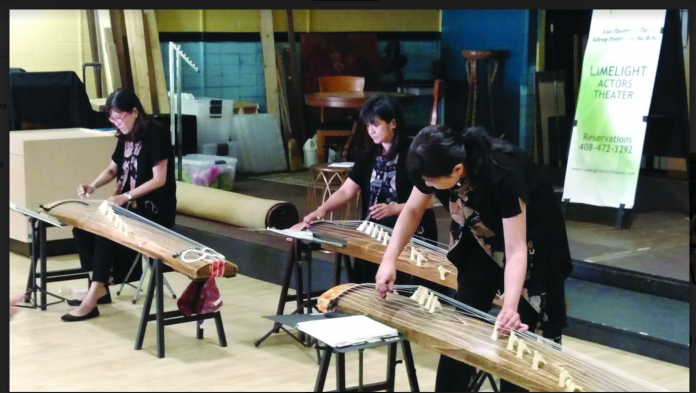
Braving 90-plus degree heat, more than a dozen children from the Suzuki Violin Music School in Morgan Hill dressed up and tucked their instruments under their chins for a performance at the first Nikkei Matsuri Japanese American Cultural Festival and Art Exhibit at the Gilroy Arts Alliance on Sept. 17.
The children, led by Lori Franke, played outside under an awning. The event also included a powerful performance by taiko drummers from Morgan Hill, who chanted and pounded away on the sunny lawn. Inside, kimonos of all colors draped the walls, and tables covered with equally colorful history filled the Gilroy Arts Center at Seventh and Monterey streets in downtown Gilroy.
When GAA wanted to put on a Japanese festival for the first time this year, festival organizer and board member Bobbi Jo Palmer said, “I decided it should be a Japanese-American festival because that’s our generation.” Palmer’s mother is originally from Japan and attended the event.
Community members brought in heirlooms that were arranged similar to the way GAA organizes its Dia de los Muertos exhibit—by family tables. Palmer’s family brought one of her mother’s kimonos, a photo of her parents when her dad was in the Air Force, fans, a doll, teapot, vase, and other framed family photos.
Marcia Hashimoto set up a tiered table of special dolls lined up on bright red carpet. The display is similar to ones used in Japanese homes with a daughter, during Hinamatsuri festival, which is celebrated every March 3. Known as Girl’s Day, people use the occasion to pray for a healthy and happy life for their daughters.
GAA vice president Alan Obata brought three encased dolls, handmade by his mother. Obata says groups of women would often get together to work on the dolls.
He also says his uncle served in the Military Intelligence Service, which was represented at the festival as part of a display of the Japanese-American experience during WWII. As interpreters, the MIS would interpret documents, listen to communications and try to break the codes of the enemy.
The exhibit’s historical display also presented information about the Japanese-American internment experience at various camps and the service of the 442nd regiment of Japanese-American soldiers.
Outside was a farmer’s market, a display from Gilroy’s Japanese sister city, Takko-machi, and an origami booth where volunteers helped children learn the art of Japanese paper-folding. Outdoor vendors also sold handmade textiles and t-shirts.
Back indoors, the live performances concluded with the musical group Marimo-Kai from San Jose—three women who sang Japanese folk songs while playing the koto, a Japanese harp. They sat in front of their long wooden instruments, which were balanced on two sawhorse-like stands. The musicians plucked with picks on their right hands, sometimes pressing frets and picking with their left fingers. They even moved the frets and adeptly turned the pages during a song.
The koto’s sound is less like an upright harp and more like a mountain dulcimer or banjo. Visitors gathered indoors to escape the heat and enjoy the music along with Japanese sodas and candies.
Crowds were steady at the festival throughout afternoon. GAA executive director Kevin Heath said, “This was our first year. We are planning to do another event next year—bigger and with more food.”












